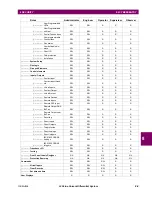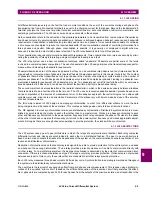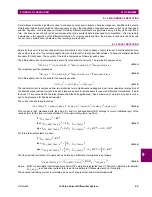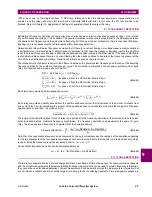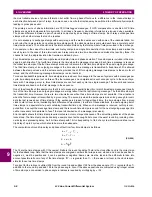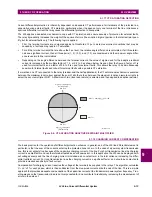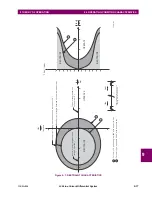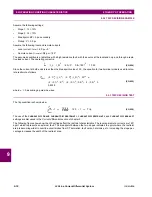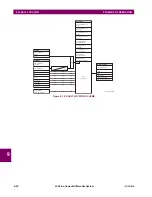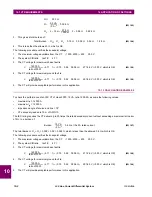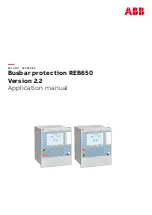
GE Multilin
L30 Line Current Differential System
9-13
9 THEORY OF OPERATION
9.1 OVERVIEW
9
9.1.17 CT SATURATION DETECTION
Current differential protection is inherently dependent on adequate CT performance at all terminals of the protected line,
especially during external faults. CT saturation, particularly when it happens at only one terminal of the line, introduces a
spurious differential current that may cause the differential protection to misoperate.
The L30 applies a dedicated mechanism to cope with CT saturation and ensure security of protection for external faults.
The relay dynamically increases the weight of the square of errors (the so-called ‘sigma’) portion in the total restraint quan-
tity, but for external faults only. The following logic is applied:
•
First, the terminal currents are compared against a threshold of 3 pu to detect overcurrent conditions that may be
caused by a fault and may lead to CT saturation.
•
For all the terminal currents that are above the 3 pu level, the relative angle difference is calculated. If all three termi-
nals see significant current, then all three pairs (1, 2), (2, 3), and (1, 3) are considered and the maximum angle differ-
ence is used in further calculations.
•
Depending on the angle difference between the terminal currents, the value of sigma used for the adaptive restraint
current is increased by the multiple factor of 1, 5, or 2.5 to 5 as shown below. As seen from the figure, a factor of 1 is
used for internal faults, and a factor of 2.5 to 5 is used for external faults. This allows the relay to be simultaneously
sensitive for internal faults and robust for external faults with a possible CT saturation.
If more than one CT is connected to the relay (breaker-and-the half applications), the CT saturation mechanism is executed
between the maximum local current against the sum of all others, then between the maximum local and remote currents to
select the secure multiplier MULT. A Maximum of two (local and remote) is selected and then applied to adaptive restraint.
Figure 9–4: CT SATURATION ADAPTIVE RESTRAINT MULTIPLIER
9.1.18 CHARGING CURRENT COMPENSATION
The basic premise for the operation of differential protection schemes in general, and of the L30 line differential element in
particular, is that the sum of the currents entering the protected zone is zero. In the case of a power system transmission
line, this is not entirely true because of the capacitive charging current of the line. For short transmission lines the charging
current is a small factor and can therefore be treated as an unknown error. In this application the L30 can be deployed with-
out voltage sensors and the line charging current is included as a constant term in the total variance, increasing the differ-
ential restraint current. For long transmission lines the charging current is a significant factor, and should be computed to
provide increased sensitivity to fault current.
Compensation for charging current requires the voltage at the terminals be supplied to the relays. The algorithm calculates
for each phase, which is then subtracted from the measured currents at both ends of the line. This is a simple
approach that provides adequate compensation of the capacitive current at the fundamental power system frequency. Trav-
elling waves on the transmission line are not compensated for, and contribute to restraint by increasing the measurement of
errors in the data set.
831744A2.CDR
MULT=1
arg(I /I )=180 degrees
(external fault)
1
2
MULT=5
MULT=1
MULT = abs(
)) x 5/180
arg(I /I
1
2
arg(I /I )= 0 degrees
(internall fault)
1
2
C dv dt
Summary of Contents for L30
Page 10: ...x L30 Line Current Differential System GE Multilin TABLE OF CONTENTS ...
Page 30: ...1 20 L30 Line Current Differential System GE Multilin 1 5 USING THE RELAY 1 GETTING STARTED 1 ...
Page 370: ...5 244 L30 Line Current Differential System GE Multilin 5 10 TESTING 5 SETTINGS 5 ...
Page 464: ...A 10 L30 Line Current Differential System GE Multilin A 1 PARAMETER LISTS APPENDIX A A ...
Page 600: ...C 30 L30 Line Current Differential System GE Multilin C 7 LOGICAL NODES APPENDIX C C ...
Page 610: ...D 10 L30 Line Current Differential System GE Multilin D 1 IEC 60870 5 104 APPENDIX D D ...
Page 622: ...E 12 L30 Line Current Differential System GE Multilin E 2 DNP POINT LISTS APPENDIX E E ...
Page 634: ...F 12 L30 Line Current Differential System GE Multilin F 3 WARRANTY APPENDIX F F ...
Page 644: ...x L30 Line Current Differential System GE Multilin INDEX ...

